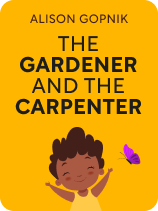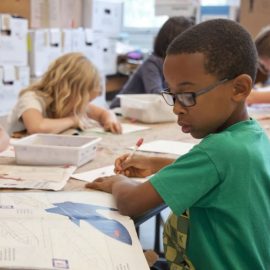

This article is an excerpt from the Shortform book guide to "The Gardener and the Carpenter" by Alison Gopnik. Shortform has the world's best summaries and analyses of books you should be reading.
Like this article? Sign up for a free trial here.
Why is conformity in schools so encouraged? How can you help promote individuality among students?
In The Gardener and the Carpenter, Alison Gopnik says schools should support and encourage children’s natural processes of learning and growth. She likens this to the work of a gardener nurturing their garden, as opposed to the work of a carpenter building something based on a specific blueprint.
Keep reading to learn how the carpenter model promotes conformity that ultimately harms older children.
Conformity in Schools
While much of Gopnik’s focus is on very young children, she addresses how the carpenter model continues to shape childcare as children grow older and how it contributes to conformity in schools. As children move past the stages of early childhood, their learning begins to center more around goals, such as developing skills that will help them succeed as adults. Gopnik notes that this presents an unavoidable contradiction in parenting—while we shouldn’t design our child care around preparing children to be adults, it’s also necessary that we teach them the skills they need to be adults. She argues that the best way to do this is to tap into children’s natural learning abilities.
(Shortform note: While Gopnik seems to view the process of preparing your kids for the real world to be at odds with letting your kids explore their natural interests, that may not be the case: Children appear to voluntarily practice skills for adulthood as young as age six. If children know what’s expected of them in the future, they willingly prepare themselves to meet those expectations. Engaging children’s natural learning abilities in preparing them for adulthood could be as simple as talking to children about their future goals and how to reach those goals.)
Prior to industrialization, the school system we use today didn’t exist. Instead, children’s education came largely from their caregivers and through apprenticeships. Children as young as six would enter into apprenticeships where they would learn and master the skills required for a certain occupation, using the methods of observation, imitation, and testimony to become adept at skills that would help them as adults. While this is still goal-directed learning and had its flaws, it tapped into children’s individual abilities and natural inclinations to observe and learn from experts through the process of trial and error.
(Shortform note: Some cultures still employ some version of the apprenticeship model. Students in Switzerland have the opportunity to train through an apprenticeship that provides them with an income while supplementing their training with a few days of in-school learning. Experts suggest that the skills they learn from apprenticeships will help them in their general lives and that they still have the option later of choosing a different path. Still, there are concerns that children shouldn’t choose a career path at such a young age, in part because their identities are still developing, and thus the apprenticeship they choose might not build upon their innate abilities in the way that Gopnik describes.)
With industrialization came a shift from apprenticeship learning to schooling. Where apprenticeships focused on giving children unique, specialized skills, schools were intended to give all children a universal set of skills for the modern world. This led to a greater and greater emphasis on standardization, which is intended to create equal opportunities for all children, but in reality often ignores children’s unique individual learning styles in favor of uniformity. Because school success is so tied to success as an adult, the carpenter schooling model reinforces the carpenter parenting model, as parents focus their efforts on making sure their children are good students instead of giving them supportive environments.
| Teaching the Right Skills and Parent Collaboration The skills taught in standardized education systems are useful but limited and don’t cover all the different skills needed in adulthood. Standardized education teaches things like critical thinking, reading comprehension, and test-taking skills, but it often neglects important functioning skills like response inhibition, emotional control, and task initiation—skills that may have been covered in apprenticeships. To prepare their children to succeed in school, parents may also focus on testing skills at the expense of other functioning skills, thereby falling into the carpenter model trap. Research shows that parents’ engagement in children’s education correlates with greater student success. But it’s much more effective when approached as a parent-educator partnership rather than as a closed system with standardized mandates that parents have to follow without the ability to give their own input. |
The carpenter schooling model, like the carpenter parenting model, views variations as flaws—or even diseases. Children who don’t fit neatly into the schooling model’s mold are often given diagnoses of conditions such as ADHD, and because the skills required for school success are not skills that come naturally to most children, such diagnoses are very widespread. We then often drug those children to make them fit the mold when we should be adjusting our schooling model to fit our children and their individual needs.
(Shortform note: Gopnik implies that a diagnosis of ADHD is the result of not fitting into the carpenter schooling model, which suggests that it’s a social construct based on our societal structure. But ADHD is a neurobiological condition that has existed throughout human history, long before today’s schooling model came into existence. Some readers may take issue with the use of the term “drugging” to describe providing children with ADHD medication. Research shows that ADHD medication is an effective treatment for the majority of children with the condition, and, contrary to what many believe, ADHD medication actually lowers the risk of drug abuse in people who have ADHD.)
Gopnik suggests that we should view schools as a place for children to grow and flourish, thereby encouraging individuality and discovery. Instead of assessing schools based on test scores, she explains, we should assess them based on observations of classrooms and on how well teachers respond to students’ individual needs and differences.
| How Effective Are Classroom Observations? Gopnik’s recommendations for assessing schools and teachers—in combination with student test scores—are already used for assessing teacher effectiveness in public schools, and these assessments are often used to reward teachers deemed to be effective or punish or remove those deemed to be ineffective. Teacher effectiveness is shown to be the number one determinant of a school’s impact on student achievement. However, research doesn’t support the idea that these evaluations have an impact on teacher effectiveness and instead shows that the location of a school (which heavily influences school funding through property taxes) and the supportiveness of a school environment toward its teachers (for example, having school leadership that encourages teachers to learn independently and providing teachers with trusting mentors) are better predictors of teacher (and thus school) effectiveness. |

———End of Preview———
Like what you just read? Read the rest of the world's best book summary and analysis of Alison Gopnik's "The Gardener and the Carpenter" at Shortform.
Here's what you'll find in our full The Gardener and the Carpenter summary:
- The difference between gardner and carpenter parenting styles
- Why parenting should not be a form of work but an act of love
- How the schooling model fails to effectively support children’s learning






